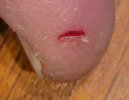Almost 40 years ago, in a conversation with Blackie Collins, he opined that there's really no such thing as a bad blade steel. If it can be hardened to above about 55RC, it can be made into a perfectly serviceable blade, ASSUMING the maker knows what he's doing with regard to design and execution. This also assumes you're not trying to chop a frozen deer hindquarter with a 6" slicing knife. In most cases, any perceived shortcomings of the steel can be overcome simply by adjusting one's cutting technique.
I'm not a steel snob. I like carbon for choppers, stainless for folders, EDC fixed blades get most of my attention. I have an assortment of steels, in both carbon and stainless alloys. I buy knives because I like the knife, not because of the steel used. That said, I'm currently carrying a Magnacut fixed and an M390 folder, just because those were the steels available when I wanted those particular designs. OK, I really did want to try Magnacut, so finding a design I like in that steel was fortuitous.

